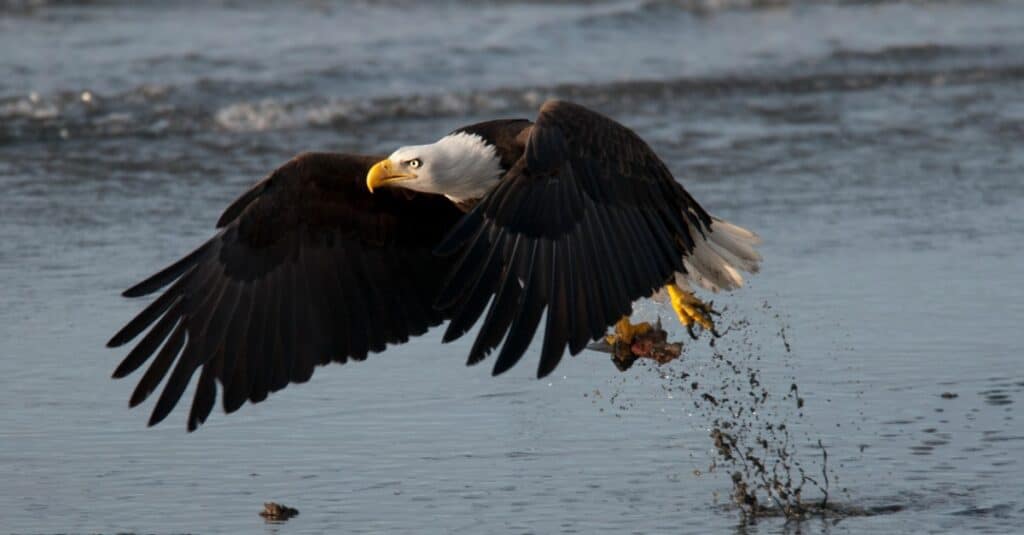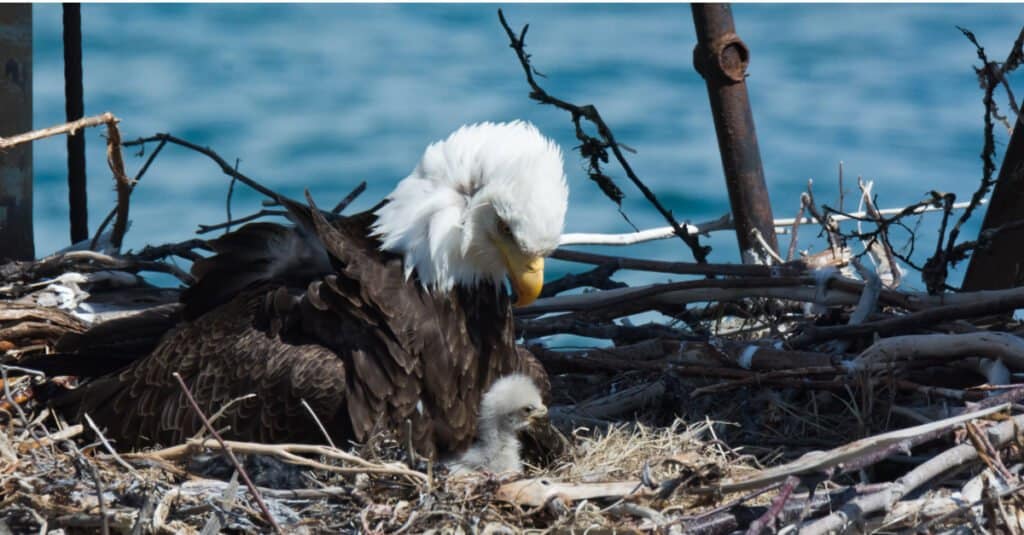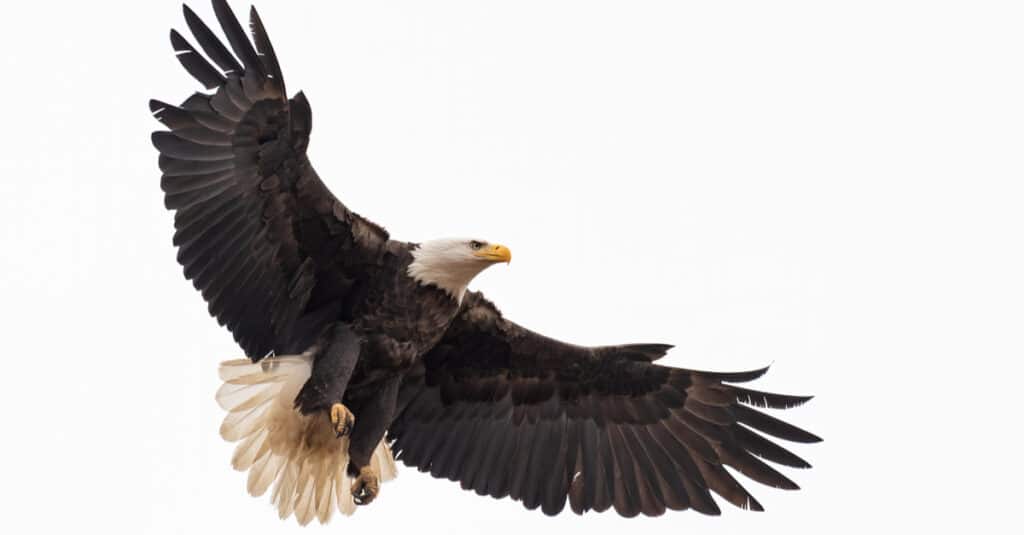Bald eagles are the national symbol of freedom and one of the most powerful birds in the world. Once on the brink of extinction, the bald eagle has quadrupled its population and is now relatively common in the United States. Still, this bird, which represents the United States closely, invokes pride and excitement. Learn about bald eagles in Texas, including where they live, how to spot them, and why they became endangered in the state.
About Bald Eagles in Texas

Bald eagles nest from October to July in Texas.
©iStock.com/Genfirstlight
While their name implies they have a bald head, the word is actually derived from the old English word “Balde,” meaning white. Their snowy white feathers cover their head and tail. They have a brown body and a yellow bill. The females are larger and weigh up to 14 pounds, with an impressive wingspan reaching eight feet.
Bald eagles mainly eat fish but are opportunistic predators and eat what is available, including waterfowl, small mammals, turtles, and other birds. To catch fish, the eagle swoops down and grazes the water surface, grabbing anything in the shallow water. These birds are excellent hunters but like to conserve energy by stealing other birds’ prey or dining on carrion (dead animals). Bald eagles have many adaptations that make them top predators, like razor-sharp talons, a huge wing span, and light-detecting cells on their retinas that help them spot prey.
These eagles reach sexual maturity by age four or five and begin breeding in early spring. Couples (bald eagles mate for life) will build their nests with grass and other material on the tops of tall, strong trees, a process that can take months to complete. They make the largest nest of any bird in North America at around six feet wide and four feet deep. The couple will return to these massive structures to mate and care for their eaglets. If they inhabit an area without trees, they build on top of a cliff or simply on the ground.
When Are Bald Eagles in Texas?
Bald eagles are active in Texas year-round. They nest from October to July, with egg-laying occurring in December and hatching in January. Eaglets fly from the nest around 11 to 12 weeks old but will stay nearby their parents for another four to six weeks while they learn to hunt. When entirely on their own, young bald eagles will migrate north but return by September or October.
A Texas nest survey concluded that more than 80% of active nesting sites successfully produced more than one eaglet. Common causes of young bald eagle mortality in Texas include disease, food insecurity, poor weather, human interference, and leaving the nest too soon.
Where Do Bald Eagles Live?

Breeding eagles inhabit the eastern half of Texas, and wintering eagles stay in the Panhandle, Central, and East Texas.
©Jon C. Beverly/Shutterstock.com
These majestic creatures live abundantly in Alaska and Canada but are also in every U.S. state except Hawaii. Bald eagles mainly inhabit woods next to rivers and lakes abundant with fish but occasionally live in arid climates. The bald eagle population in Texas is divided into two groups: breedings birds and wintering birds.
You can find bald eagles in Texas year-round, but which group you see depends on the location and time of year. Breeding eagles inhabit the state’s eastern half and along the coastal counties from October to July. During winter, the non-breeding birds stay in the Panhandle, Central, and East Texas. Find out where you can go to watch these beautiful creatures.
Where to Spot Bald Eagles in Texas
Winter is prime time for watching bald eagles. Luckily, there are several spots in Texas perfect for these birds. However, eagles come and go from their nests as they please, and there is no guarantee that you will see one. But, here are some areas with the highest possibility of a bald eagle sighting.
Brazo Bend State Park

Brazo Bend State Park has bald eagle viewing opportunities from December through March.
©Randy G. Lubischer/Shutterstock.com
The state park boasts multiple large bodies of water, hiking trails, camping, and wildlife viewing. Just 40 minutes from Downtown Houston, you can visit a popular birding destination with over 300 bird species. From December through March, you can view bald eagles within the park limits, and you will have great opportunities to see one around the big lakes like Elm Lake.
Sheldon Lake State Park
This state park is also close to Houston and provides a natural oasis with lakes, woodlands, ponds, wetlands, and prairies. There is an 84-foot observational tower that overlooks Sheldon Lake and is the perfect spot to bring a pair of binoculars and look for bald eagles. It’s also an excellent place to take pictures, as the Houston skyline and the San Jacinto Monument are in the background. The park is open from sunrise to sunset.
Hagerman National Wildlife Refuge

Lake Texoma is a pristine location for watching bald eagles in Texas.
©iStock.com/asiantiger247
Located on Lake Texoma is Hagerman Wildlife Refuge, a year-round sanctuary with reliable bald eagle sightings. The large lake is a pristine location for these eagles because it provides an abundance of hunting grounds and potential nesting sites. Bald eagles are often spotted around the Wildlife Drive area, and early morning is the best time to catch them being active.
Armand Bayou Nature Center
This nature center is one of the largest wildlife preserves in the country and provides five miles of walking trails, a bison viewing center, and boat tours. The best areas to see bald eagles are at the Bay Area Park Boardwalk or on the pontoon boat tour, but anywhere near the bayou is a good place. Bald eagles and osprey migrate to the center around September to prey on fish.
Canyon of the Eagles
This nature park and resort is near Lake Buchanan, where you can rent kayaks or take a river cruise. The lake is a prime location for eagle watching year-round, especially from October to March during nesting season. Take advantage of the many hiking trails and look out for the nests or see if you can spot one fishing in the lake. The park also offers bald eagle viewing expeditions from November through February.
The photo featured at the top of this post is © FloridaStock/Shutterstock.com
Thank you for reading! Have some feedback for us? Contact the AZ Animals editorial team.






